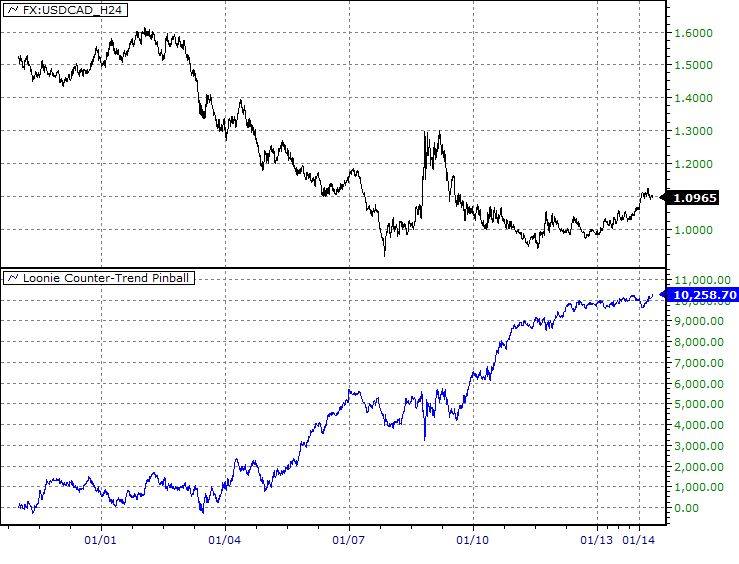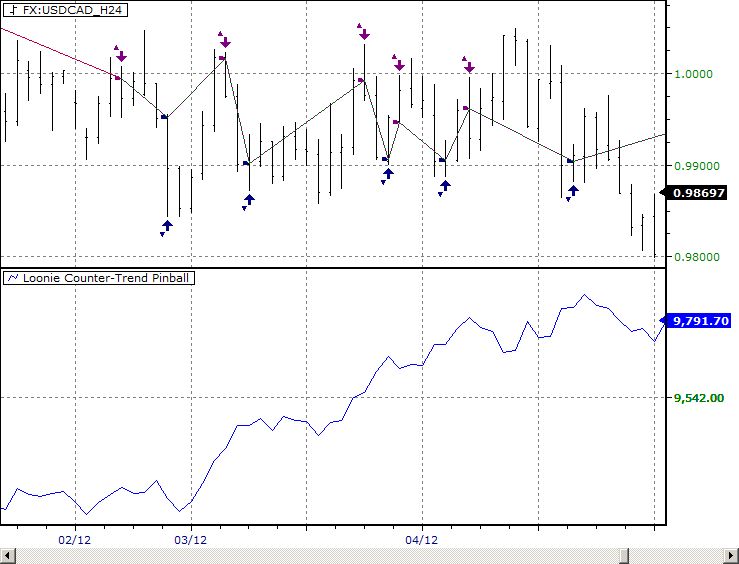The Canadian Dollar (Loonie) has been the bane of mechanical swing trading systems for a long time. The way it moved over the past 10 to 15 years have changed many characteristics it once processed. Many swing trading models are no longer profitable because they are over optimized against just one to two years of immediate history. Here I present a simple counter-trend trading model, Loonie Counter-Trend Pinball, that does not exhibit this problem and trades the Canadian Dollar profitably.
This strategy is called Loonie Counter-Trend Pinball for three reasons. First, it is a loony approach because it violates the common belief that moving average is a tool for trend identification. Second, it is counter-trend by design. Third, it behaves like a pinball around the daily traded price range.
In case you are not interested in the name, you will be interested to know that this swing trading model has a winning rate exceeding 70% and very profitable over the years.
Canadian Dollar Is Special Among The Majors
Canadian Dollar loves to overlap its trading range from the past few days much more than the other majors. In fact, Euro Dollar does not even exhibit this characteristic on a consistent basis. This makes Canadian Dollar unique among the forex majors where simple counter-trend strategies can produce positive results. The difficulty is to find a way to produce a stable trading model that we know it will likely perform well into the future.
The Loonie Counter-Trend Pinball Strategy
The strategy is designed to work with USD/CAD daily bars.
There are only three rules to follow:
1. Always in the market
2. Go long when USD/CAD closes below 20 days simple moving average – 20% of 20 days average range
3. Go short when USD/CAD closes above 20 days simple moving average + 20% of 20 days average range
Performance
Following is a chart of USD/CAD daily bars with the net gains in pips for the strategy since year 1999. Two pips are removed from each closed trade to account for slippage.

Overall the strategy has a winning rate of 76%. Both long and short trades show more than 70% winning with short side pushing near 80%. This shows the system is well balanced.
USD/CAD net changed about 7,000 pips during the whole tested period while the strategy netted 10,000 pips. On daily basis, this model has done an excellent job in extracting profit from the market.
This is a swing model that trades about 20 to 30 times a year which is at par to other swing trading models.
Counter-Trend And Pinball Like Behavior
Many traders use the moving averages as trend confirmation tools. It is common to see traders will stay clear from going long when the market is trading below their favorite moving averages and vice versa. For our trading strategy here, however, it is doing the opposite of what trend followers would do. It fades the moves once the price has crossed over the moving average by the threshold.
The strategy is counterintuitive but it works very well over the years.
The following chart is a close-up of what actually happens from day to day with the trading system. Notice the way the model keeps switching direction as if it is trying to outguess the market for the turning points. It moves like a pinball trapped in the contraptions looking for a way out.

Optimization
The use of 20 everywhere in the strategy is not a result of optimization. 20 days simple moving average is a very common moving average used by the traders for identification. As oppose to using it as a means of looking for the current trend, I am using it to identify potential exhaustion, or safe price level where mean reversion will likely take place sending the price to the other side of the moving average.
Readers can experiment on the idea by optimizing the strategy with separate moving averages and parameters for the generation of long and short signals. Since the strategy works well with many parameters combinations, it will not be difficult to get better results over the generic setup I have presented here.
Importance Of The Logic Behind The Strategy
The mechanical model presented shows that the way Canadian dollar moves on daily basis is exploitable. The statistical characteristics in its behaviour lead to the possibility of using counter-trend techniques to extract profit from its price movements. The exact method being used is not as important as an overall understanding what can be done to make money from trading the Canadian Dollar.
Discretionary traders can learn from the results of this strategy that it is a valid approach to fade the extreme moves in Canadian dollar. The strategy also offers an objective way to quantify the condition for which Canadian dollar has over extended its moves. In short, traders can use the mechanical model as an overbought / oversold pre-condition to seek for counter-trend trading opportunities.
Room For Improvement
Although the strategy performs very well over the years, it has its bad times when a strong trend suddenly develops out of nowhere. This means money management stop orders can help reduce the volatility in the equity curve during the turbulent times.
Advanced models can be built on top of this raw model by utilizing it as a directional filter instead of being the trigger of the strategy. Employing intraday data, one can refine the entries so that the model will not enter a trade blindly when everything else is telling us the entry is too early.
This raw trading model is a strong foundation for anyone to build their complete trading strategies.
= = =
Lawrence Chan is an independent trader / hedge fund consultant who started his professional trading career as an exchange option trader back in early 1990s. He is known for his research work on market breadth analysis and price discovery process. His website DaytradingBias.com offers trading signals and cloud-based trading tools for forex and index traders. More information available at daytradingbias.com
Related Reading
Read another story by this author:
UK Official Bank Rate Bearish Play




